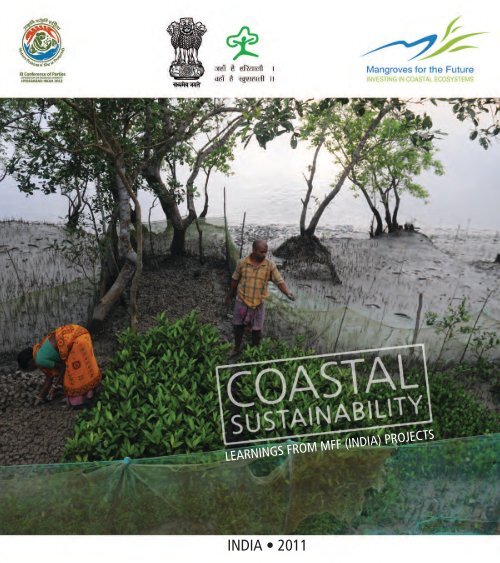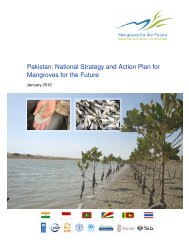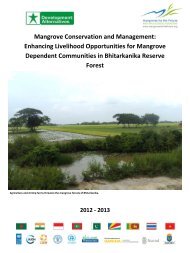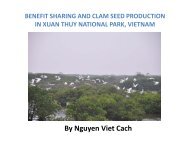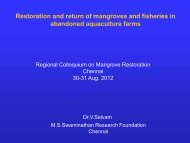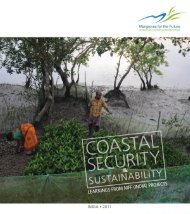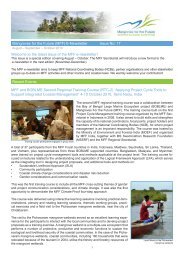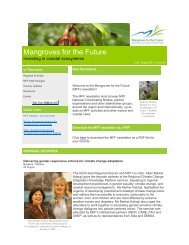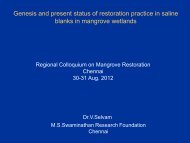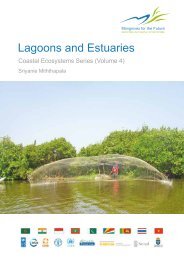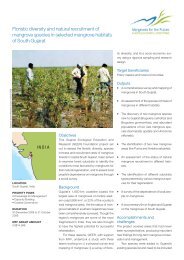Coastal Sustainability: Learnings from MFF India projects
Coastal Sustainability: Learnings from MFF India projects
Coastal Sustainability: Learnings from MFF India projects
Create successful ePaper yourself
Turn your PDF publications into a flip-book with our unique Google optimized e-Paper software.
LEARNINGS FROM <strong>MFF</strong> (INDIA) PROJECTSINDIA • 20111
Produced by the Mangroves for the Future (<strong>MFF</strong>) <strong>India</strong>20, Anand Lok, August Kranti Marg, New Delhi 110049with financial support of Norad and Sida© 2012 IUCN, International Union for Conservation of Nature and Natural ResourcesCitation: D’Souza N. and Ishwar N. M. 2012, <strong>Coastal</strong> <strong>Sustainability</strong>:<strong>Learnings</strong> <strong>from</strong> <strong>MFF</strong> (<strong>India</strong>) Projects, IUCN <strong>India</strong> Country Office, New Delhi, 32ppAll rights reserved.No part of this publication may be reproduced in any form or by any means without the prior permissionof the IUCN and <strong>MFF</strong>.The designation of geographical entities in this book, and presentation of the material, do notimply the expression of any opinion whatsoever on the part of IUCN, International Union forConservation of Nature and Natural Resources or The Mangroves for the Future (<strong>MFF</strong>) Initiativeconcerning the legal status of any country, territory, or area, or of its authorities, or concerning thedelimitation of its frontiers or boundaries. The views expressed in this publication do notnecessarily reflect those of IUCN or the <strong>MFF</strong> Initiative, nor does citing of trade names orcommercial processes constitute endorsement.Available <strong>from</strong>: IUCN <strong>India</strong> OfficeCover Photo: Sayantan BeraEditorial design: Pradip SahaPrinted at Impress, New Delhi
LEARNINGS FROM <strong>MFF</strong> (INDIA) PROJECTSMANGROVES FOR THE FUTURE SINCE 2006MEMBER COUNTRIESINDIA • INDONESIA • MALDIVES • SEYCHELLES • SRI LANKA • THAILAND • PAKISTAN • VIET NAMOUTREACH COUNTRIESBANGLADESH • CAMBODIA • MYANMAR • TIMOR-LESTE
PHOTOS: PRADIP SAHA
Restoring <strong>India</strong>’s CoastlineMany of us will never have to stand at land’s end, watching the incoming tide, and wonderhow to feed our families. But more than 20 million people in <strong>India</strong>, living along its coasts,depending on a delicate balance between ocean and land ecologies, are doing exactly that today.<strong>India</strong>’s 7,517 km coastline spans 13 states and Union Territories and is a complex web of saltmarshes, mangrove forests, rocky coasts, coral reefs, sea grass meadows and offshore islandswhich buffers the nation <strong>from</strong> the force of the ocean. Major global coral reef systems exist here;the Andaman Islands account for nearly 80 per cent of the world’s coral diversity. Moreover, thecoastline hosts five per cent of the world’s mangrove forests 1 , with over 125 plant species 2 . Indeed,mangroves are the symbolic mascot of <strong>India</strong>’s varied coastal ecology.Approximately 26 per cent of the country’s population lives within 100 km of the coastline 3 .Largely impoverished, they rely on the ocean and the coast for their livelihoods.Today, both coastline and people face disequilibrium. The characteristics of the coast are changing,forcing us to ask important questions about the future of its ecology. People’s lives, too, seem edgier;like the flora and fauna on which they depend, they are today more vulnerable to changes.The well-being of the coast does not depend solely on the coastal population; it is affected byactivities and aspirations on the mainland. Thus, coastal ecologies are affected by mainland economicgrowth and urbanization. Some of <strong>India</strong>’s largest urban centres — Mumbai, Chennai, Kolkata — arealong the coast. These cities, and others, discharge untreated domestic sewage and industrial effluentinto the oceans every day. Hundreds of chemical compounds pour into the oceans, disturbing thefine balance between saltwater and freshwater. Intensive shrimp farming threatens mangroves.Growing poverty is pushing local populations to use mangroves for fuelwood. Excessive groundwaterwithdrawal and dwindling flow in rivers have increased salinity in coastal areas. Much of the changeexperienced is a result of human activities focused on economic growth.Subsistence farmers, fisherfolk and all the communities linked with these groups face extremehardship. With no transferable skills, the millions living at land’s end will move mainland-wards, tocity centres and push an infrastructure, already stressed, to its limits.And there is another puzzle to solve: climate change. Rising sea levels are eroding coasts.Shrinking beaches have put fishermen in further trouble. The frequency and intensity of coastal stormsand cyclones have increased. Upto 7.1 million people stand to lose their livelihoods 4 . The tsunami of2004 was a rude reckoning of how vulnerable these communities really are in the face of extremeand unpredictable changes in their environment.Fortunately, science today understands better the reasons for the observed changes on <strong>India</strong>’s coast.The Government of <strong>India</strong> has also taken note and engaged in the process of restoring 3 these fragilehabitats, by reviewing policies such as <strong>Coastal</strong> Regulation Zones (CRZs) and Marine Protected Areas (MPAs).Grassroots communities and organizations are also becoming more proactive in saving coastal ecology.Fortunately, talk has turned into a lot of action.
PHOTO: PRADIP SAHA4PHOTO: PRADEEP VYAS
<strong>MFF</strong> (<strong>India</strong>): Investing in <strong>Coastal</strong> FuturesThe 2004 tsunami was a call to action for the international community; its aftermath demonstratedthe extreme fragility of coastal ecosystems and the livelihoods of those who depend on these.In response to this crisis and with an objective to put into place local solutions, Mangroves for theFuture (<strong>MFF</strong>) began their work across the countries most affected in South and South East Asia.<strong>MFF</strong> is present in eight member countries and its actions are decided, and overseen by, a RegionalSteering Committee (RSC) co-chaired by IUCN and UNDP. The RSC ensures that all programmes underthe <strong>MFF</strong> banner are consistent with regard to vision and mission.In recognition of the action needed to protect <strong>India</strong>’s coastlines and the communities dependenton them, Mangroves for the Future (<strong>India</strong>), known as <strong>MFF</strong> (<strong>India</strong>) was launched in late 2007. In orderto ensure that ground level work is ultimately translated to have replicable impact, ownership isrequired at all levels. Keeping this in mind, <strong>MFF</strong> (<strong>India</strong>) has been stressing on meaningful and variedpartnerships since its inception.The Government of <strong>India</strong> has taken special cognizance of the work required to protect its diverseand unique coastal and marine habitats. A National Coordinating Body (NCB) was created in 2007,to institutionalize the work of <strong>MFF</strong> (<strong>India</strong>) and its vision. The ownership of the Government is clearand the Additional Secretary, Ministry of Environment and Forest (MoEF), Government of <strong>India</strong> is theNCB chairperson. There are 16 members of the NCB, bringing together individuals with skills <strong>from</strong> allrelevant backgrounds, comprising eminent persons <strong>from</strong> the Government, international and national<strong>MFF</strong> (<strong>India</strong>)SMALL GRANTSCOMMUNICATIONSACTION RESEARCHTRAINING &WORKSHOPSKNOWLEDGEPRODUCTSOPINIONPOLICY5
civil society, private sector, academic and research institutions. The presence of NCBChairperson in the RSC ensures that <strong>India</strong>’s specific concerns are addressed and that actions takenwithin the National programme are supported by the <strong>MFF</strong> vision.The roadmap for <strong>MFF</strong> (<strong>India</strong>) has been developed in its National Strategy and Action Plan (NSAP).This framework document outlines the priorities for <strong>MFF</strong> (<strong>India</strong>) in line with those of the country andis in line with <strong>India</strong>’s National Environmental Policy and Biodiversity Action Plan for maximumintegration between policies and action. The NSAP has identified five coastal states for field levelinterventions: West Bengal, Andhra Pradesh, Tamil Nadu, Orissa and Gujarat. However, applications<strong>from</strong> other states are also eligible.In 2008, applications for action research under the Small Grants Programme were put forwardby a variety of actors, looking to better understand the causes and impacts of changes on <strong>India</strong>’scoastal habitats and the effects these have had on the livelihoods of the coastal population. Theseactors range <strong>from</strong> community-based organizations to government institutions. Nine <strong>projects</strong> were• LIVELIHOOD SECURITY AND SUSTAINABILITY• COASTAL AND MARINE BIODIVERSITY RESEARCH• INFORMATION AND KNOWLEDGE DISSEMINATIONselected, each for a duration of between 3 months to 15 months, and for an individual project costof up to USD 25,000. Each project focused on one of three areas: livelihood security and sustainability,coastal and marine biodiversity research, information and knowledge dissemination. These <strong>projects</strong>were complemented by ongoing training for <strong>MFF</strong> (<strong>India</strong>) project partners and knowledge productsaimed at taking the learnings <strong>from</strong> <strong>MFF</strong> (<strong>India</strong>) to a wider audience.<strong>MFF</strong> (<strong>India</strong>) programme has a strong and conscious focus on action interventions. The processof action research is intrinsically catalytic, where results obtained in the short-term can be translatedinto more institutionalized processes. The phase of action research provides a scientific baseline forcommon understanding and allows for informed decision-making.Mobilizing change cannot come without the active participation of all stakeholders thatcontribute to, and can benefit <strong>from</strong>, changes in practices that focus on living within the planet’snatural boundaries. One of the most important features of the <strong>MFF</strong> (<strong>India</strong>) programme has been theactive participation of the private sector. The private sector views <strong>MFF</strong> (<strong>India</strong>) as a strong knowledgepartner and the first phase of action research will result in options for further work, throughco-financing of interventions and active private sector support.6
The core objective of <strong>MFF</strong>’s work is to develop sustainable action and awareness. Beyond actionsof the coastal population, coastal ecology is highly affected by economic activities on the mainland.Keeping this, and the need for a long-term solution in mind, <strong>MFF</strong> (<strong>India</strong>) also undertakes knowledgedissemination <strong>projects</strong> and capacity building exercises, especially targeted towards researchers andpolicy makers.In its work between 2008-2011, <strong>MFF</strong> (<strong>India</strong>) not only facilitated informed change, but alsoensured that agents of change were localized. Small grants were seen as a way to support localactions and provide immediate local benefit. In addition to the small-grants framework, the selectionof strong and established project partners increased the potential that the work would extend beyondthe project period.The results of work done under the auspices of <strong>MFF</strong> (<strong>India</strong>) until 2011 have been very positiveand it is clear that the small grants framework can act as catalytic seed investment for sustainableand scalable change. These successes are evident in the reports of the <strong>projects</strong>. Moreover, all <strong>projects</strong>were selected on their potential for policy leverage. The fruits of this are also clear. In many of thecase studies, the small grants <strong>projects</strong> have been adopted for further exploration by governmentagencies. In addition, the effective inclusion of the private sector has lead to new understandings ofpossible partnerships. The positive, results based, integration of private sector into the work done by<strong>MFF</strong> (<strong>India</strong>) has prompted the Government of <strong>India</strong> to include private-sector representation in thenational committee looking after coastal and marine issues.<strong>MFF</strong> strongly believes in investing in coastal futures by developing natural infrastructure. Thesecond phase of the work for <strong>MFF</strong> (<strong>India</strong>) will continue to operate within a small and medium grantsframework, with a major focus on the policy potential of the project proposals. It is also expectedthat the continuing concerns in the region about the coastline will require <strong>MFF</strong> (<strong>India</strong>) to undertakecollaborative programmes with neighbouring countries. In this way, <strong>MFF</strong> (<strong>India</strong>) expects to build anational and regional cadre of individuals, organizations and private sector players who can take themessages of coastal conservation and livelihoods forward.SMALL GRANTSLARGE STEPS7
SMALLGRANT 01CORAL REEFS OF INDIA–CURRENT STATUS, THREATS ANDCONSERVATION MEASURES: A NATIONAL WORKSHOPSuganthi Devadason Marine Research Institute (SDMRI), TuticorinWorkshop at Tuticorin, Tamil NaduPHOTO: DEEPAK APTE8
Gulf ofKachchhCo-Financing/Contribution In-KindSustainableReplicablePolicy/AdvocacyCommunityParticipationAndaman &Nicobar IslandsTuticorin • Gulf of MannarLakshadweepNR: Not relevantNONRNRYESNRCoral reefs are key indicators of coastal health. They are home to many fish species. Althoughcoral reefs cover less than 0.1 per cent of the ocean they support almost one quarter of marinebiodiversity 5 . They are also natural barriers to protect coastlines <strong>from</strong> the ferocity of tidal waves.Reefs are under severe threat by pollution and human actions. In recognition of the importance ofreefs within the coastal habitat, and to mark the end of the International Year of the Reef 2008, <strong>MFF</strong>(<strong>India</strong>) started work by hosting a national workshop. In December 2008, the national workshop onthe Coral Reefs of <strong>India</strong> was held at Tuticorin, a port town off the Gulf of Mannar in Tamil Nadu. Thefocus was on coral reefs and coastal ecology. Representatives <strong>from</strong> all the four major reef areas in<strong>India</strong> were present: the Gulf of Mannar, Gulf of Kachchh, Lakshadweep, Andaman & Nicobar Islands.The main objective of the workshop was to bridge geographic differences and develop commonpriorities for future work on coral reef research and conservation management in <strong>India</strong>.The workshop was held under the auspices of the Ministry of Environment and Forest,Government of <strong>India</strong> and had 51 representatives <strong>from</strong> around the country. The workshop focused onfive main areas: Coral Status and Conservation; Coral Associates; Coral Diseases and MolecularStudies; Reproduction, Recruitment and Restoration; and Coral Environment and Threats. It broughttogether government officials, civil society actors, scientists and students.The focused subject of the workshop, with its diverse range of representatives, provided a uniqueopportunity for the compilation of knowledge, across disciplines, in the five subject areas. This alsoallowed for valuable identification of knowledge gaps between research, academia, field practiceand policy. As with all workshops bringing together delegates with a similar professional objective,or geographic background, similarities were found with respect to challenges and opportunities forcontinued work. The need for a holistic perspective on reef conservation was agreed upon.28 research papers were presented within the five-pillar framework. These broad predefined researchareas ensured that not only quantitative science was highlighted for discussion, but also socialsciences and the impact of lifestyles on coral health.The papers presented at the workshop were peer reviewed, and 26 of them were compiled intothe publication Coral Reefs in <strong>India</strong> – status, threats and conservation measures. This knowledgeproduct will be an important baseline for research, taking note of all relevant coral reefs and coralecology. This will also provide a useful base for advocacy groups to build awareness at the local level.Beyond local level actions, the workshop and the publication will go a long way in helping tounderstand the status of reef ecology and the changes that are required in enabling policy frameworks.Once information is compiled and documented, multiple actors can address gaps in policy, actionand research. Knowledge products such as Coral Reefs of <strong>India</strong> – current status, threats andconservation measures are also valuable tools for new actors, and new communities interestedin the topic of coastal ecology.9
SMALLGRANT 02STUDY OF FLORISTIC DIVERSITY AND NATURAL RECRUITMENTOF MANGROVE SPECIES IN SELECTED MANGROVE HABITATS OFSOUTH GUJARATGujarat Ecological Education and Research (GEER) Foundation, Gandhinagar<strong>Coastal</strong> Research in Southern GujaratPHOTO: BHARAT JETVA10
South GujaratCo-Financing/Contribution In-KindSustainableReplicablePolicy/AdvocacyCommunityParticipationYESYESYESYESYESThe coastline along the southern part of Gujarat is under severe threat <strong>from</strong> spreading humanhabitation and industrial activities. The increasing pressures of community dependence onmangrove forests has been linked with its decreasing density. No clear study has been done of themangrove forests in southern Gujarat and there was a clear need to codify the existing status andto better understand the relationship between the livelihoods of local communities and the abilityof the mangroves to regenerate.Gujarat’s 1,650 km long coastline hosts 936 sq km of mangrove forests. This state in western<strong>India</strong> is home to 22 per cent of <strong>India</strong>’s mangrove population 6 . This study focused on developing astatus survey of the mangrove forests in southern Gujarat.Through the process of mapping, mangrove species in south Gujarat were recorded for thefirst time. Sonneratia apetala and Avicennia officinalis are two mangrove species thought to be veryrare, but were found growing in abundance in south Gujarat. Two new mangrove areas were identifiedin Navsari and Valsad districts. Additionally two mangrove species Bruguiera cylindrical and Bruguieragymnorrhiza were rediscovered, increasing the total list of mangrove species in Gujarat to 15. Suchinformation is particularly useful for the forest department in order to understand naturally occurringareas for future plantation development.In addition to compiling information on biological and ecological mangroves in the area, thestudy specifically focused on the intimate linkages between local communities and the use of themangrove forests for livelihoods. In order to plan for future conservation activities, this symbioticrelationship will need to be understood. Alternative options will then need to be developed if themangrove forests are no longer to be tapped.The study results not only provide a better understanding for stakeholders like the forestdepartment, when planning mangrove restoration, it also leads to better better-informed awarenesscampaigns in the area. A film, in both English and Gujarati, was developed with a focus to promotethe awareness of the importance of mangroves and subsequent conservation. The Chief Minister ofGujarat released the film and as such raised the importance of the issue to the attention of the state.The film was made, outside of the project budget, by the project partners, and indicated theirlevel of ownership with regard to awareness actions. In May 2009, a report of the project findingswas also published and presented before the State Level Steering Committee for the conservation ofmangroves and coral reefs.The project was particularly successful in making clear the value of strategic dissemination andawareness building of key decision makers at all levels of policymaking. The Purna Estuary studiedin south Gujarat is under consideration at the state level as a biodiversity hotspot. Another study sitehas been marked as a potential genetic resource centre. The Ministry of Environment and Forest isfinancing a mapping exercise of mudflats by the project partner. This project clearly demonstratesthe value and potential of small grants as catalysts that can ensure second generation actions.11
SMALLGRANT 03SUSTAINABLE COASTAL LIVELIHOOD INTEGRATED MANGROVEFISHERY FARMING SYSTEMM.S. Swaminathan Research Foundation (MSSRF), ChennaiVellar-Pichavaram-Coleroon Estuary, Cuddalore district, Tamil NaduPHOTO: V. SELVAM12
• PichavaramCo-Financing/Contribution In-KindSustainableReplicablePolicy/AdvocacyCommunityParticipationYESYESYESYESYESEvolution of our knowledge about coastal habitats shows us that ecosystems aren’t only naturalresource reserves. They are three-dimensional matrices involving, and impacted by, not just theocean but the people who work and live within them. The growth of shrimp farming in <strong>India</strong>, <strong>from</strong> asmall scale cottage industry activity in the 1980s, illustrates this evolving dynamic.By the 1990s shrimp farming was growing at 8.4 per cent a year. Attracted by revenue potential,farmers converted coastal agricultural land into shrimp farms. With intensive activity, there was acorrelated increase in inputs required to sustain coastal aquaculture. With increased use of artificialfeed, practice of monoculture, combined with poor environmental management, productivity startedto fall. In 1996 the Supreme Court put a halt to intensive shrimp farming. Intensive farming practicesand the legal ban left shrimp farmers, who had converted their lands, without a livelihood. This resultedin up to 60 per cent of landowners abandoning their farms along the coast.This project was developed as a model to showcase potential for rectification of the impacts ofbad farming practice and the legal ban. The action research study, in the Vellar-Pichavaram-Coleroonestuarine region in Cuddalore district, Tamil Nadu, looked to innovative ways of working with shrimpfarmers to enable sustainable community-based fish farming systems. It involved reclaimingabandoned lands and building local infrastructure such as bunds and embankments, to plantmangrove habitats. The farm area was then fed with mangrove-based fishery seeds and organicinputs for their development. Tidal water also provided natural feed and oxygen at no cost to thefarmer. The use of tidal water in the demonstration sites allowed not only community-based livelihoodoptions to be developed, but also introduced an energy-efficient method of production.The demonstration sites were successful. Organic inputs, like dead fish or organic waste, replacedsynthetic feed. The organic feed improved species health and growth as well as survival rates ofthe transplanted mangroves. A parallel social process of building capacity and creating awarenessensured sustainability at project sites. Through hands-on demonstrations, workshops, groupdiscussions and exposure visits, farmers assimilated the potential of the Integrated Mangrove FisheryFarming System (I<strong>MFF</strong>S).The project went beyond restoring lost livelihoods. It extended livelihood opportunities: Women wereprovided with options for alternative livelihoods with the use of air-conditioned chillers to help them sellfish. Women also received training on producing organic pesticides, that was then sold to farmers.Beyond farmers, the ambit of dissemination related to the viability of I<strong>MFF</strong>S was broadened toforest department officials and central government ministries. That helped dissipate prevailingpessimism — local as well as at the official level — about using abandoned shrimp farms. Indeed,the study’s demonstration of how abandoned saline ponds could be used, whilst also restoringecosystem balance, went a long way in convincing owners of degraded land and abandoned shrimpfarms to participate, by providing their land at no cost. This proved that it is possible to combineecological restoration and generation of alternative livelihood.Using field knowledge, the project created an enabling policy environment that allowed forreplication. Now, the Aquaculture Authority of <strong>India</strong> is considering the I<strong>MFF</strong>S model to be eligible foreco-labeling, given its environmental advantages and potential for carbon sequestration. IMFSS’s clearsuccess is best demonstrated by the fact that the central government wants it up-scaled in many states.13
SMALLGRANT 04CRITICAL EVALUATION OF ALTERNATE LIVELIHOODPROGRAMME IMPLEMENTED TO REDUCE DEPENDENCE ONSUNDARBANS MANGROVESDepartment of Forest, Government of West BengalSundarbans Biosphere Reserve, West BengalPHOTO: PRADEEP VYAS14
•SundarbansBiosphereReserveCo-Financing/Contribution In-KindSustainableReplicablePolicy/AdvocacyCommunityParticipationYESYESYESYESYESThe coast along the Bay of Bengal, spanning <strong>India</strong> and Bangladesh, is home to an estimated4.2 million people, all beholden to the Sundarbans ecosystem 7 . Such dependence as well asunregulated mangrove exploitation has consistently stressed the ecosystem. Numerous <strong>projects</strong> havetried to combat this state of affairs, but because actions taken — to conserve mangroves whileimproving livelihood opportunities — have not been systematically analysed, there was nocomprehension of which key success factors were worth replicating.Thus this project was designed by the Sundarbans Forest Department, to understand changesfor effective action. To fathom, for instance, the extent mangroves are actually used. The projectreviewed previous actions, evaluated impacts. The intent: an intervention strategy with the highestpotential for sustainable success.The project focused on all 14 Eco-Development Committees (EDCs) and 51 Forest ProtectionCommittees (FPCs) with which the forest department had worked in the SundarbansBiosphere Reserve (SBR). Its purpose was to provide recommendations to improve upon previousinterventions, for future work on conservation and for building partnerships with communities.Documenting all actions undertaken in the recent past by the forest department also aimed to providea balance between man and nature. The project analysed the results and sustainability of pastinterventions, using questionnaires, focus group discussions and groundtruthing.The project studied over three decades of information on fuelwood and honey collection andfishing in the mangrove forests, including a review of the extent of illegal practices. The data provideda baseline to understand what communities required <strong>from</strong> the forest. The database also acted as anindicator of the extent of alternative livelihood generation required to safeguard the forest.Eco-tourism was seen as one alternative. EDCs currently get 25 per cent of the revenue derived<strong>from</strong> eco-tourism; the study recommended an increase in the benefit-sharing for EDCs.Goateries, piggeries and beekeeping were other alternative livelihoods.This socio-economic survey revealed that for change to be truly sustainable, there was animmediate need to understand the communities that live in, and off, the Sundarbans. It showed thatsimple infrastructure development in public areas could do as much for mangrove conservation asresource awareness generation. Building roads, jetties, community centres and solar power wouldimprove community well being, and provide better potential for processing and marketing products.In turn, such actions would improve trust levels between the communities and the forest department,enabling more participation. The findings also suggested promotion of energy-efficient cookstoves, toreduce firewood dependence.The study highlighted the vulnerability of these populations to extreme weather events, such asAila, the super-cyclone of 2009. It clearly illustrated the need to understand the lives of the communitywithin this backdrop, before suggesting alternative livelihoods. As a direct result, <strong>MFF</strong> (<strong>India</strong>) hasnow included Disaster Risk and Reduction (DRR) strategy to be incorporated in future project workin this location. The study made clear the importance of challenging predefined stereotypes whenengaging with forest-dependent communities.15
SMALLGRANT 05STATUS OF SHELTERBELTS IN SOUTHERN INDIACOASTAL LINEEnvironment Protection Training & Research Institute (EPTRI), Hyderabad<strong>Coastal</strong> areas in Orissa, Andhra Pradesh, Tamil Nadu, Puducherry, Kerala, KarnatakaPHOTO: PRADIP SAHA16
KarnatakaKeralaCo-Financing/Contribution In-KindSustainableReplicablePolicy/AdvocacyCommunityParticipationNR: Not relevantOrissaAndhra PradeshTamil NaduYESNRYESYESNRWith the devastating impact of the 2004 tsunami, and its aftermath, attention is now beingpaid to developing bioshields or shelterbelts against possible future extreme weather events.Hard solutions such as sea walls are often the first point of recourse when thinking about protecting<strong>India</strong>’s coastlines. More attention needs to be paid to soft solutions such as shelterbelts, that haveproved to be sustainable and cost effective, when planning for the future. Bioshields are land’s firstdefence against the power of the ocean’s tide and winds. The importance of these barriers isspecifically relevant with the increasing frequency and intensity of cyclonic storms.The first step in understanding the potential of planting shelterbelts along <strong>India</strong>’s coastlinerequires an understanding of the current status of existing shelterbelts. This information will contributeto developing a comprehensive strategy for coastline protection. The Environment Protection Trainingand Research Institute (EPTRI) mapped the coastline across Karnataka, Kerala, Tamil Nadu, AndhraPradesh and Orissa. In addition to providing a dynamic status report of the coastline, EPTRIinvestigated the extent to which human activity impacted and will continue to impact existing coastalland use and land cover.This information was compiled using secondary information and comprehensive questionnairesin order to understand and document the extent of present shelterbelts coverage upto two km inlandof the coast. Satellite maps were used in order to cross-reference ground level data, but also toprovide possible sites for the cultivation of new shelterbelts. The state forest departments werethe primary sources of data but project site visits were carried out to understand the impacts ofanthropogenic activities.While the effects of anthropogenic activities were clearly evident, the study also showed thatthe reasons for degraded ecosystems went beyond population pressures and livelihood stress ofspecific local communities. The role of industrial pollution, decreasing freshwater flows due toupstream activities and siltation were also key indicators of decline, especially of mangroves.The study illustrated the key components required for coastal restoration efforts includingpotentials for new mangrove generation. Joint planning by all stakeholders including localcommunities, the forest department and NGOs was seen to be critical to the success of interventionefforts. The creation of village level mangrove committees meant that all stakeholders had equalopportunity to participate in the process of restoration. The high levels of participation led to a greatersense of ownership and ultimately resulted in sustainable conservation actions.Non-mangrove shelterbelts were also documented in the study and provided an additionalunderstanding of the potential for future activities. Efforts at mixing agriculture, plantations andsilviculture were documented as success stories, both with regard to shelterbelt creation but alsowith possibilities for livelihood generation.Perhaps most importantly, what the project showed was the success that could be achieved inminimizing the impact of storm surges inland through the development and careful planning ofbioshields. The report and supporting maps provide a useful toolkit for local forest departmentrepresentatives and government to prepare for future activities on developing shelterbelts.17
SMALLGRANT 06MANGROVE CONSERVATION AND REGENERATIONAT MITHAPURTata Chemicals Society for Rural Development (TCSRD), MumbaiMithapur, Okhamandal region, GujaratPHOTO: SATISH TRIVEDI18
•MithapurCo-Financing/Contribution In-KindSustainableReplicablePolicy/AdvocacyCommunityParticipationNR: Not relevantYESYESYESNRYESMangrove forests that once flourished along <strong>India</strong>’s coastal landscapes are now largely barrenas a result of the impacts of economic activity and anthropogenic actions. In order tounderstand the importance of human behaviour and economic activity, ownership and activeengagement of all actors is required.TCSRD, a trust run by private sector giant Tata Chemicals, undertook a study to understand thepotential of restoring coastal wastelands for mangrove plantations. The selected site was a 215hectare revenue wasteland located at Rukshmani Creek on the Mithapur coast in Gujarat. 20 hectares,that had been impacted by over-exploitation of fuelwood and fodder collection, overgrazing, pollutioninflows and consecutive years of drought, were selected for work. TCSRD hoped to show that throughplanned and systematic action, wastelands could be restored and that by doing this livelihood couldbe positively impacted through the provision of alternate livelihoods.In order to restore the project site, land was selected nearby to develop a mangrove nursery. Thisnursery received regular tidal inflows, critical for the growth of mangrove plants. Local communitieswere trained to cultivate the nursery and ultimately transplant the mangrove seedlings to thewasteland. The seeds for the nursery were selected <strong>from</strong> the Avicenna mangrove species easily accessiblein the project area. Over 52,400 seedlings were transplanted into the project area.The core of this project was the way in which it focused on developing local capacity throughincentive mobilization and education. Women were trained for nursery management, which was acentral activity to ensure the success of the overall project. This earned them 466 days of employmentduring the project period and created opportunities for future alternative livelihoods. Additionally,youth mobilization through the development of eco-clubs was one of the main project actions. Theseeco-clubs reached out to students and cultivated youth leaders to be the brand ambassadors formangrove conservation in the area.The strength of the project lay in the team approach that TCSRD brought to the interventionlogic. The Gujarat Forest Department was, at all times, kept informed of the project process andultimately agreed to ensure the maintenance of the plantations being set up within the project scope.TCSRD’s commitment to the project deliverables was cemented by the fact that they contributedtwo-thirds of the project finances.TCSRD continues its work, beyond the project period, of mangrove restoration, in the remaining195 hectares of the wasteland area and will focus on developing eco-clubs and creating ruralentrepreneurship activities for the local communities.Working to conserve and restore any ecosystem cannot be the refuge of only one set of actors.Ultimately sustainability and replicability of interventions will be realised if all stakeholders are involvedin the project process. As many of the causes of anthropogenic stress are due to the attempts by peopleat the bottom of the income pyramid to survive, it is not surprising that interventions that focus onfinancially viable alternatives for livelihood choices are very likely to succeed in immediate uptake.19
SMALLGRANT 07SUSTAINABLE FRESHWATER AQUACULTURE IN MANGROVEDOMINATED INDIAN SUNDARBANSDepartment of Marine Science, University of Calcutta, KolkataJharkhali, 24 Parganas District, Sundarbans, West BengalPHOTO: ABHIJIT MITRA20
•SundarbansCo-Financing/Contribution In-KindSustainableReplicablePolicy/AdvocacyCommunityParticipationYESYESYESYESYESIn mangrove areas, especially in that of the Sundarbans in the Bay of Bengal Delta, raising freshwaterprawns has been largely a subsistence activity, done in a traditional method with low-level inputs.Traditional practice focused on fertilising the prawn ponds with manure <strong>from</strong> cattle or poultry. Assupplementary feed, rice or wheat bran is used, in addition to oil seed cakes. However with increasingdemand prawn culture has become a more intensive, commercial activity. As a result farmers arefocused on total yields, with a correlated focus on per unit size and weight as per market requirements.For prawn farmers, this current demand on the yield and size of the final product resulted in thefocus of feed shifting to commercially available protein-rich inputs such as meats and flesh of livemussels. It has been understood that the sustained use of such protein feeds had an overall negativeimpact on water quality in the landscape and ultimately the survival of the prawns themselves.This project focused on using science to complement traditional practices for prawn feed. It aimedat developing feed that relied on inputs that were locally available and could improve the quality ofthe water bodies. It aimed at having an overall positive impact on the survival and size of the prawns,thereby boosting economic opportunity whilst also improving environmental sustainability.The challenge of the project was twofold; it first had to find a locally available alternative to thecommercial feed for the prawns, but it also had to demonstrate, within the project period, the potentialto match if not surpass the yield and health of the prawns that were raised on commercial feed. Thiswould be critical in establishing the confidence of the prawn farmers to take the actions forward.The study, done in the 24 Parganas district of West Bengal, examined the possibilities ofdeveloping eco-friendly nutritive feed for freshwater prawns. Land for the project was provided freeof cost by farmers and two ponds were developed throughout the project period. The first pond wasa control site, where traditional methods were employed using commercial feed. The second pondwas tested with alternative feed options and compared to the control for the health of the prawnsand the water quality of the pond.Porterasia coarctata, a locally available salt marsh grass, combined with soy bean dust, mustardoil cake, rice and wheat bran, with vitamins and minerals was found to be a viable alternative feedfor the prawns. This had overall positive impact on the growth rates of the prawns as well as thewater quality of the pond. The floral feed was also found to improve the colour of the prawns andregulate their final size. This positively impacted the market potential of the final product.In addition to the positive impacts of the alternative feed in the pond, new livelihoodopportunities for local women were generated when upscaling this activity by developing nurseriesfor the salt marsh grass.The project served to generate large amount of interest <strong>from</strong> the local community, whounderstood the long-term benefits of switching feed. Based on the positive experiences coming outof the study, a guidebook in Bengali was developed for local farmers. The forest department is keento upscale and promote this practice as it leaves the environment cleaner.This project has shown that science and research can overcome local concerns on environmentalsustainability and enhance economic returns. The long-term viability of this project, despite the locallevel successes, will depend on the marketing of the intervention to coastal communities.21
SMALLGRANT 08MANGROVE RESTORATION AND AFFORESTATION:PARTICIPATORY ASSESSMENT OF CURRENT PRACTICESM.S. Swaminathan Research Foundation (MSSRF), ChennaiMangroves in Tamil Nadu and Andhra PradeshPHOTO: V. SELVAM22
Andhra PradeshCo-Financing/Contribution In-KindSustainableReplicablePolicy/AdvocacyCommunityParticipationNR: Not relevantTamil NaduYESNRNRYESYESIt is only relatively recently that we have come to understand the importance of conservingmangrove forests within the coastal habitat. In the 1990s mangrove conservation measures werefocused on re-plantation but were varied in their results. The challenges for the successful uptake ofconservation policy measures needed more discussions with regard to the socio-economic incentivesthat might be required for sustainability of mangrove restoration. Although mangrove managementand restoration activities have increased with the availability of funding opportunities, there hasbeen no clear prescriptive understanding of how best to channel research for the most effectiveoutput and impact.The M.S. Swaminathan Research Foundation (MSSRF) focused on the coastal belt of Tamil Naduand Andhra Pradesh to assess, understand and document some of the main concerns in traditionalmangrove restoration practices. They focused on biases in species selection for mangrove restorationand its subsequent impacts, as well as the way in which livelihood concerns and community participationwere considered. Joint Mangrove Management (JMM) actions, in participation with the forestdepartment and local communities, were also investigated. The study developed recommendations forsocial, institutional and policy linked strategies for mangrove restoration and afforestation measures.The study found that although the mangrove cover had increased as a result of consistent activityon conservation and restoration, there had been a decline in the relationships among all stakeholders.The project identified a steady decline in contact points between the forest department and villagecommunities. For real ownership, the JMM needed to be strengthened by a larger participation of allstakeholders such as NGOs and local communities. Ownership, on the part of local communities, wasseen to be an important indicator of longevity in intervention actions.Further, the work done indicated the importance of seeing local communities in a holistic fashionand to understand their needs beyond the mangroves. Welfare schemes and housing were seen astwo important components that came out of the study that impacted the overall well-being ofcommunities and their potential to engage with conservation activities. Access to cooking gas in themangrove areas was also seen as an important way of decreasing stress on forests being used forfirewood. Village Forest Councils (VFCs) or stakeholder forums were indicated as critical componentsfor sustainability of intervention strategies. These forums provide an important role in confidencebuilding and empowerment on the part of mangrove dependent communities.Policy linkages are important when leveraging work done in coastal belts, such as those in TamilNadu and Andhra Pradesh. The study brought forward that large-scale national policy packages suchas the National Rural Employment Guarantee Scheme (NREGS) have to integrate with local specificrealities for maximum impact.23
SMALLGRANT 09ASSESSING SELECTIVE TRACE METAL CONTAMINATION OFEDIBLE BIVALVES FROM ESTUARINE REGIONS OF GOANational Institute of Oceanography (NIO), PanajiMandovi–Zuari–Cumbarjua Estuarine Complex, GoaPHOTO: NIO24
•GoaCo-Financing/Contribution In-KindSustainableReplicablePolicy/AdvocacyCommunityParticipationYESYESYESYESYESThis study, by the National Institute of Oceanography (NIO), aimed to determine trace metalconcentrations in bivalves, specifically oysters and venerid clams. These species are importantto the Goan economy and form a fulcrum of activity to the coastal communities that harvest them.Along <strong>India</strong>’s coastlines, rising levels of pollution <strong>from</strong> industrial activity are impacting thelivelihoods of the poorest communities. Bivalves such as Crassostrea gryhoides (oysters) and Paphiamalabarica (venerid clams) are an important part of the nutritional diet of the coastal Goancommunity. Edible and flourishing along the 200 km mangrove belt on the Central West Coast, thesebivalves provide an important opportunity for livelihood support. However, mining along Goa’s rivers,that invariably meander into the Arabian sea, are causing metal seepage into the aquatic environment.This has raised concern for human health, as well as aquaculture. Bivalves accumulate metalpollution in their tissues faster than other organisms. So, their health becomes an interesting way ofunderstanding the potential impacts of mining activities along the central west coast in Goa.The NIO project focused on ascertaining the relationship between metal contamination andenvironmental conditions, such as increased mining activities along the rivers. The research involvedmeasuring trace metals in water, sediments and the tissue of bivalve catches. The study aimed tohelp people engaged in bivalve collection find safer spots.The study found that the trace metal goes up significantly during monsoon and post-monsoon.This clearly implicates the health of women engaged in bivalve collection. Also, the presence of metalin tissues implicates the health of consumers. Post-monsoon traces of cadmium in tissues of bothC. gryphoides and P. malabarica were recorded as very high and beyond permissible levels. Higherpresence of cadmium can be linked to use of fertiliser in agriculture. Iron in water, sediment andbivalve catch was very high, varying 100 to 1,000 times higher than permissible levels. This clearlyindicates the effect of iron mining in Goa.The project made awareness for fisherfolk about the potential impacts on human health a centralpart. Women fisherfolk were trained to understand the effects of metal poisoning in humans.This study has had important consequences for developing a relationship between upstreamhuman activities and downstream human livelihoods. Moreover, such information educates the publicabout the impacts of changing environments on human health. In the case of the central west coast,Goa, the results will impact tourism, another large income opportunity for coastal communities.Monitoring of metal contamination of bivalves will continue. At the same time, responsible use ofthe information will be critical when working with the communities, who haven’t created the problem,but have everything to lose due to its impact.To combat metal pollution, utmost care should be taken to treat the effluent before releasing tothe environment.25
Bridging the GapIn addition to steering the National programme with its partnerorganizations, the <strong>MFF</strong> (<strong>India</strong>) Secretariat undertakes outreach initiatives,with an aim to fill the capacity and knowledge gap at the National, stateand local levels around coastal conservation and restoration. Specifictarget groups for these products are public officials, academicians andall stakeholders working with and on coastal habitats.PublicationsThese knowledge products are demand driven and are also developedout of the learnings and findings of local <strong>projects</strong> to ensure their relevancefor project management. Recently, Mangroves: Guardians of the Coast,a video has been developed focusing on mangroves which will bescreened by <strong>India</strong>’s national TV channel. A blog, http://fishtalesindia.orgis also online to target youth and give them the chance to not only learnabout, but discuss issues relating to freshwater marine life and coastalecosystems.Capacity Building<strong>MFF</strong> (<strong>India</strong>) works with stakeholders to help them develop a betterunderstanding of the tools required to work within coastal conservation,be it through workshops on project writing skills, scientific writing orknowledge seminars on Integrated <strong>Coastal</strong> Zone Management (CZM). Aspart of this, <strong>MFF</strong> (<strong>India</strong>) hosted a regional workshop in Thailand, in August2011, focused on strengthening science communication in project results.An international workshop was also held by M.S. Swaminathan ResearchFoundation (MSSRF) to discuss current and future research and policyinterventions required for coastal conservation. More than 100 internationaldelegates participated, including <strong>MFF</strong> countries, which served to strengthenproject results and further opportunities for future work.In addition, <strong>MFF</strong> (<strong>India</strong>) aims to provide centralized documentation anddissemination of best practices, success stories as well as challengeson programme uptake, so that all its partners may benefit <strong>from</strong> theexperiences of the programme collective.26
Communities living as part of South Asia’s coastal ecosystems are some ofthe world’s poorest with high vulnerability and low resilience to changeMangroves and the coastal ecosystems of which they are a part are centralto biodiversity and mainland protection, whilst also providing a livelihoodopportunity for millions of peopleIn order to bridge the challenges posed to coastal ecosystems, we must findways to make man and nature work togetherPHOTO: PRADIP SAHA28
<strong>MFF</strong> (<strong>India</strong>): Steering AheadThe <strong>MFF</strong> (<strong>India</strong>) Small Grants programme has provided valuable steps towards a betterunderstanding of the potential for coastal ecosystem conservation and regeneration. <strong>MFF</strong> (<strong>India</strong>)will continue its commitment to the Small Grants programme. A second round of small grants hasbegun with an aim to find new findings and new research that can enrich policy inputs for coastalconservation. Already, the importance of developing recovery plans for endangered species like whalesharks and gastropods is being highlighted for incorporation in the <strong>MFF</strong> (<strong>India</strong>) programme.Additionally <strong>MFF</strong> (<strong>India</strong>) will develop management plans for sensitive habitats such as seagrass beds(Gulf of Mannar) and the Vembanad-Kol backwaters, in Kerala, one of the largest wetlands in <strong>India</strong>.The next steps of <strong>MFF</strong> (<strong>India</strong>) will be multidimensional – working at project and policy levels,and at all times being informed by the results of action-research and scientific debate. Continuedcapacity building for coastal states will contribute to effective conservation plans for mangrovesand the work done will feed into Integrated <strong>Coastal</strong> Zone Management (ICZM). At the same time,a focus on trade policy and incentives will be extended in order to prevent over-exploitation of themangrove forests.The impacts of coastal habitat destruction and the dependency of communities on the forestsfor their livelihoods are not determined necessarily by nationality or state borders. The lessons learntthrough the <strong>MFF</strong> (<strong>India</strong>) programme will be applicable across South Asia, where coastal ecosystemsare unified by geography and circumstance.In addition to understanding the nuances at play in the rapidly shifting coastal ecosystemlandscape, the economic incentives at play in this area have to be brought into clearer focus. <strong>MFF</strong>(<strong>India</strong>) will work with the private sector in Gujarat to develop environmentally sustainable coastalarea development. The work done by the forest department in West Bengal, on alternative livelihoods,and the results it provided in the short span of the project time, has paved the way for a greaterunderstanding of how relationships between direct stakeholders can be improved. This work willnow be extended in the form of a large grant in Sundarbans. The project will be co-financed by <strong>MFF</strong>(<strong>India</strong>) and the West Bengal Forest Department.<strong>Coastal</strong> ecosystems will continue to be dependent on actions upstream, as much as those inthe immediate environment. Economic growth incentives and livelihoods will need to be broughtinto consistently greater focus when understanding the opportunities for coastal futures. <strong>MFF</strong> (<strong>India</strong>)will continue its work to develop knowledge products so that all stakeholders can understand therealities at play at land’s end.29
References1. Ministry of Environment and Forests, Government of <strong>India</strong>, (2010), Achieving 2010 BiodiversityTargets: <strong>India</strong>'s Contributions: Goal 1 fact sheet, New Delhi2. Kathiresan, K. (2008), Mangroves and their associates in coastal <strong>India</strong>. National Workshop on'Mangrove in <strong>India</strong>: Biodiversity, Protection and Environmental Services', Institute of WoodScience and Technology, Bangalore3. Jorge, M.D.R., Lourenco, N., Machado, C. R. and Rodrigues, L. (2002), Measuring, monitoringand managing sustainability in <strong>India</strong>n coastal areas: the socioeconomic dimension,Eurocoast, Portugal4. Sinha, P.C. (2006), Sea Level Rise due to Global Warming and Climate Variability, Centre forAtmospheric Study, <strong>India</strong>n Institute of Technology, Delhi5. Mulhall, M. (2007), Saving rainforests of the sea: An analysis of international effortsto conserve coral reefs, Duke Environmental Law and Policy Forum,Bucknell University, Pennsylvania6. Untawale, A.G. and Jagtap, T.G. (1991), Floristic Composition of Deltaic Regions of <strong>India</strong>,Memoirs Geological Society of <strong>India</strong>, Geological Society of <strong>India</strong>, Bangalore7. Spalding, M., Kainuma, M. and Collins, L. (2010), World Atlas of Mangroves, Earthscan, UK &USA30
PHOTO: PRADEEP VYAS31
About this BookThis publication shares the experiences and lessons learnt <strong>from</strong> <strong>MFF</strong> (<strong>India</strong>) small grant <strong>projects</strong>,and its own initiatives of various publications and on national, international workshops on coastaland marine biodiversity research and management and other capacity building initiatives.This book is an abridged narrative of the <strong>projects</strong> and the authors have heavily relied on the finaltechnical reports of the implementing partners. The complete technical reports of these small grant<strong>projects</strong> can be found at the <strong>MFF</strong> (<strong>India</strong>) website: www.mangrovesforthefuture.org/india<strong>MFF</strong> <strong>India</strong> would like to thank the NCB, especially Mr. M F Farooqui, Special Secretary, MoEF andChair, NCB <strong>India</strong>, and Dr. J R Bhatt, Advisor, MoEF and Member Secretary NCB <strong>India</strong>, for all theirsupport and advice.The implementing partners of <strong>MFF</strong> (<strong>India</strong>) small grant <strong>projects</strong>:Suganthi Devadason Marine Research Institute (SDMRI), TuticorinGujarat Ecological Education and Research (GEER) Foundation, GandhinagarM.S. Swaminathan Research Foundation (MSSRF), ChennaiDepartment of Forest, Government of West BengalEnvironment Protection Training & Research Institute (EPTRI), HyderabadTata Chemicals Society for Rural Development (TCSRD), MumbaiDepartment of Marine Science, University of Calcutta, KolkataNational Institute of Oceanography (NIO), Panaji32
About <strong>MFF</strong>Mangroves for the Future (<strong>MFF</strong>) is a partner-led initiative promoting investments in coastalecosystems for sustainable development. <strong>MFF</strong> provides a collaborative platform for countries,sectors and organizations to address challenges to coastal ecosystem and livelihood issues;thus directing them towards a common goal.<strong>MFF</strong> builds on a history of coastal management, before and after the 2004 <strong>India</strong>n Ocean tsunami,particularly the need to continue the momentum and partnerships generated by the immediatepost-tsunami response. Initially focusing on six countries worst-affected by the tsunami, <strong>India</strong>,Indonesia, Maldives, Seychelles, Sri Lanka, and Thailand, <strong>MFF</strong> has expanded to include Pakistanand Viet Nam. <strong>MFF</strong> will continue to reach out to countries in the region that face similar issues,with an overall aim to promote an integrated ocean wide approach to coastal zone management.<strong>MFF</strong> seeks to achieve demonstrable results in influencing regional cooperation, nationalprogramme support, private sector engagement and community action. This will be achieved usinga strategy of generating knowledge, empowering institutions and individuals, to promote goodgovernance in coastal ecosystem management.Learn more at: www.mangrovesforthefurture.org<strong>MFF</strong> <strong>India</strong>IUCN <strong>India</strong> Country Office20, Anand Lok,New Delhi – 110 049<strong>India</strong>Telefax: +91 11 262 57 742Email: india@mangrovesforthefuture.org<strong>MFF</strong> SecretariatMangroves for the Future (<strong>MFF</strong>)63, Sukhumvit Soi 39Bangkok – 10110ThailandTelephone: +662 662 4029Fax: +662 662 4389Email: secretariat@mangrovesforthefuture.org


